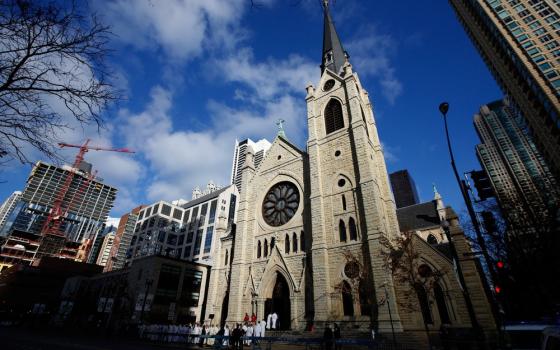Our faith journeys often manifest as a dialogue between freedom and discipline -- the freedom to relate to each other and the world in our unique way, the discipline to forsake that which stands between us and God.
These two elements are linked by choice: to begin a discipline requires the freedom to choose it, to make freedom meaningful requires choosing disciplines which limit it. In my last essay, I used the work of Thomas Merton to argue the church must clear a path for believers to delve into their inner lives and search for answers to their most penetrating questions.
To help cultivate the discipline it longs for in its followers, the church must also yield to Christians the freedom to choose the ways which they will interact with the outer world of art and culture.
Sr. Wendy Beckett, the beloved consecrated virgin who rose to fame as an art critic for the BBC, is among the most eloquent voices bringing a Christian perspective to aesthetics. In a wide-ranging interview in 1997, journalist Bill Moyers asked Beckett about one of the most controversial works of art in modern times: Andres Serrano's "Piss Christ," a photograph of a plastic crucifix in a bottle of the artist's own urine.
To suggest the work is blasphemous, Beckett argues, is "rather begging the question." Blasphemy is in the eye of the beholder; so too is art's ultimate impact. Even hating a work of art like Serrano's is ‘comforting,’ Beckett says, if the work doesn't force us to take on a new perspective.
“Real art,” she says, “makes demands.”
Beckett's argument raises important implications for working definitions of sin. Censors frequently argue shocking art acts as a temptation towards bad acts, or a weight dragging down our collective moral conscience. Their critics argue instead that viewing art is unrelated to good or bad action.
Both sides miss an essential actor in the artistic conversation: the culture which a work of art refers to and extends. Art arises amidst particular conceptions of human persons in community -- real art causes its viewer to evaluate their place in that community under previously unknown terms. Artistic expression is both the adoration of divinely created human capacity and a continuous challenge to the dull platitudes that allow us to love God and our neighbor less than fully.
The church has legitimate reason to distrust contemporary culture, particularly for its tendency to make persons into objects and romanticize violence. Paradoxically, however, returning subjectivity to women and men requires leaving them, one by one, as the agents of their expressive lives.
While the era of outright censorship by the church has ended, elements of Christian culture continue to promote the suppression of some works. "Piss Christ" has gone through a tumultuous history, first as a flash point in the debate over NEA funding in 1989, most recently as the subject of vandalism last April.
Pressure from Christian political groups and the Speaker of the House resulted in the removal of David Wojnarowicz' "A Fire in My Belly" from the National Portrait Gallery in December. Similar stories appear across artistic disciplines, particularly in literature, movies and television.
While formal and informal censorship always happens in bits and pieces, these instances set a tone for the church's interaction with an increasingly diverse culture. At best, they suggest a certain distance between Christian and secular interpretations of the world. At worst, they show an unwillingness to engage artistic work on its own terms.
Our right to choose what we consume, however, places on us a corresponding responsibility to rise to art's real demands. In a world overflowing with media, what we consume says important things about who we are.
Authentic artistic expression, in Beckett's formulation, avoids needless shock and confrontation just as it avoids the trite or overly sentimental. Real art makes demands by walking the thin line between tradition and revolution, consistency and change, fiction and truth.
Just as comforting art can face harsh scrutiny, however, real art can fall on under-prepared ears.
Developing a holistic, critical and inter-textual artistic mind, to delight in representations of the creative work of God, is not only an important part of developing our humanity. It is an obligation to our spiritual selves.
[Chase Nordengren is a graduate student at the University of Washington in Seattle, where he studies education policy. Among other projects, he edits a set of reflections on contemplative spirituality called "At Once Good and Imperfect" at goodandimperfect.net.]
| Editor's Note: We can send you an e-mail alert every time a Young Voices column is posted to NCRonline.org. Go to this page and follow directions: E-mail alert sign-up. If you already receive e-mail alerts from us, click on the "update my profile" button to add Young Voices to your list. |




